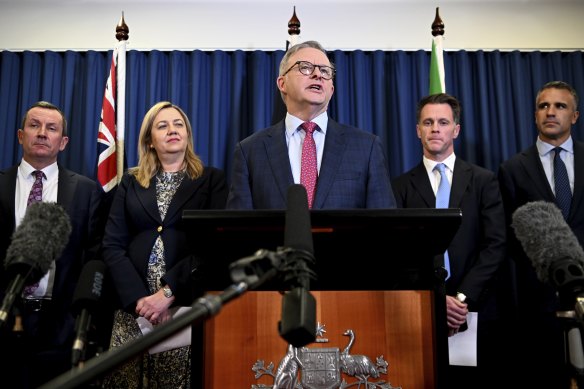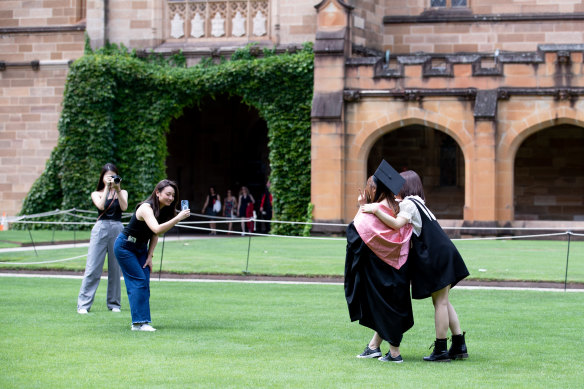- Exclusive
- Politics
- Federal
- Immigration
This was published 1 year ago
Record migration revealed: 400,000 to arrive this year
By David Crowe
Australia’s migrant intake will soar to its highest level on record as 400,000 people enter the country this year in net terms, sparking a debate among federal and state political leaders over new housing measures and tougher visa rules to deal with the influx.
Students will make up almost half the intake as they take advantage of the removal of COVID border controls, leading to a one-off surge in net overseas migration that will fall to 315,000 next year and could decline further once the new measures take effect.

Prime Minister Anthony Albanese with state premiers after Friday’s national cabinet meeting in Brisbane.Credit: Dan Peled
Prime Minister Anthony Albanese vowed to give state and territory leaders more input into migration policy to ease pressure on capital cities, using a national cabinet meeting on Friday to outline three new housing measures and discuss the population forecasts to be included in the federal budget on May 9.
Albanese emerged from the meeting to announce a $2 billion increase in support for social and affordable housing as well as two tax changes to increase the financial incentives for investors and developers to build more homes.
The national cabinet meeting also launched a push to harmonise protections for renters across the states and territories on issues such as the frequency and amount of rent increases, although Albanese played down the prospect of the laws being the same in each jurisdiction.
A key federal objective is the construction of 1 million homes over five years from 2024 in a national housing accord led by Treasurer Jim Chalmers and backed with state support.
Victorian Premier Daniel Andrews has backed the housing accord and NSW Premier Chris Minns, attending his first national cabinet meeting after winning the state election, wants greater urban consolidation along transport corridors to ease housing pressures.
“More skilled migrants – and more support for skilled migrants so they can build a life in Australia – is key to our economic recovery and growth as a nation,” a Victorian government spokesman said.
The revised forecast for net overseas migration is a sharp increase on the estimate of 235,000 in the October budget and reflects the sudden arrival of students after their home countries, such as China, removed restrictions on their travel.
Of the increase of 165,000 in the forecast since October, about 70 per cent are students. Of the 400,000 in net overseas migrants this year, about half are students.
Net overseas migration is the net gain or loss of population through international migration to and from Australia. It is calculated by measuring overseas migrant arrivals and subtracting overseas migrant departures.
The Australian Bureau of Statistics measures this by considering whether a traveller is in or out of the population for 12 months during a period of 16 months after their arrival or departure.
Coalition immigration spokesman Dan Tehan has ramped up the political debate on the migration intake in recent days by accusing Labor of planning a “big Australia by stealth” and losing control of temporary worker arrivals.
With debate building on housing policy – canvassed in this masthead’s Broken Dream series on the issue over the past week – Greens leader Adam Bandt has called on the federal government to get the states and territories to impose a rent freeze nationwide.
But Albanese called on the Greens and the Coalition to back the government’s $10 billion Housing Australia Future Fund, which is currently stuck in the Senate, as the best way to finance new homes.
The $2 billion measure outlined on Friday will support the National Housing Finance and Investment Corporation to raise finance for social and affordable rental homes and help community housing providers.
The tax changes comprise a cut in the withholding tax rate from 30 to 15 per cent for managed investment trusts with foreign investors when they invest in build-to-rent properties after July 2024, along with an increase in the depreciation rate from 2.5 per cent to 4 per cent per year for eligible new build-to-rent projects when construction starts after 9 May this year.
The effect is expected to be an increase in investment in affordable housing because the financial returns are greater.
The budget forecasts will show the Australian population remains lower in the years ahead than forecast before the pandemic, when net overseas migration slumped to a rare negative result of 85,000 in the 2021 financial year because departures exceeded arrivals.
This means the cumulative migration intake will take until 2029 to recover to the levels forecast before the pandemic, according to a government official aware of the forecasts but not authorised to speak publicly on the issue.
The unusual spike in arrivals this year mirrors the trend after the Spanish influenza pandemic that followed the First World War, when net overseas migration amounted to 3 per cent of the population in 1919. This year’s intake will be 1.5 per cent of the population.
Home Affairs Minister Clare O’Neil is working on three policy measures that are expected to reduce the migration intake from the rare high this year.
The first is an increase in the income benchmark applied to all temporary workers, known as the Temporary Skilled Migration Income Threshold and due to rise from $53,900 to $70,000 in July in a decision O’Neil announced on Thursday. This removes an incentive for low-paid foreign workers to enter the country.
The second is, by July, reducing the hours a foreign student can work to 24 each week, ending the unrestricted work rights the Morrison government introduced during the pandemic.
A broader reform of the foreign student program will be decided by O’Neil with Education Minister Jason Clare and Skills Minister Brendan O’Connor in the next few months to prevent people using the system to take low-paid jobs.
The three measures are expected to lead to a lower forecast for net overseas migration when Treasury updates the outlook in future budgets.

Now that borders have reopened, 70 per cent of the new intake are foreign students. Credit: Edwina Pickles
University of Melbourne demography professor Peter McDonald has cautioned against some of the concern in the media about the social pressures from the migration intake, noting that “very little” of the increase comes from permanent resident visas.
“The impacts of this temporary surge in net migration on the labour force and housing are complex and cannot be interpreted in the simplistic terms now evident in much of the media,” he wrote in The Conversation.
“The high level of net migration is largely due to people remaining in Australia instead of leaving. Almost all of these people were already working in Australia and were already housed.
“Furthermore, students are often housed in student accommodation or live in extremely crowded circumstances, while working holiday makers often live in backpacker hostels.“
Cut through the noise of federal politics with news, views and expert analysis from Jacqueline Maley. Subscribers can sign up to our weekly Inside Politics newsletter here.